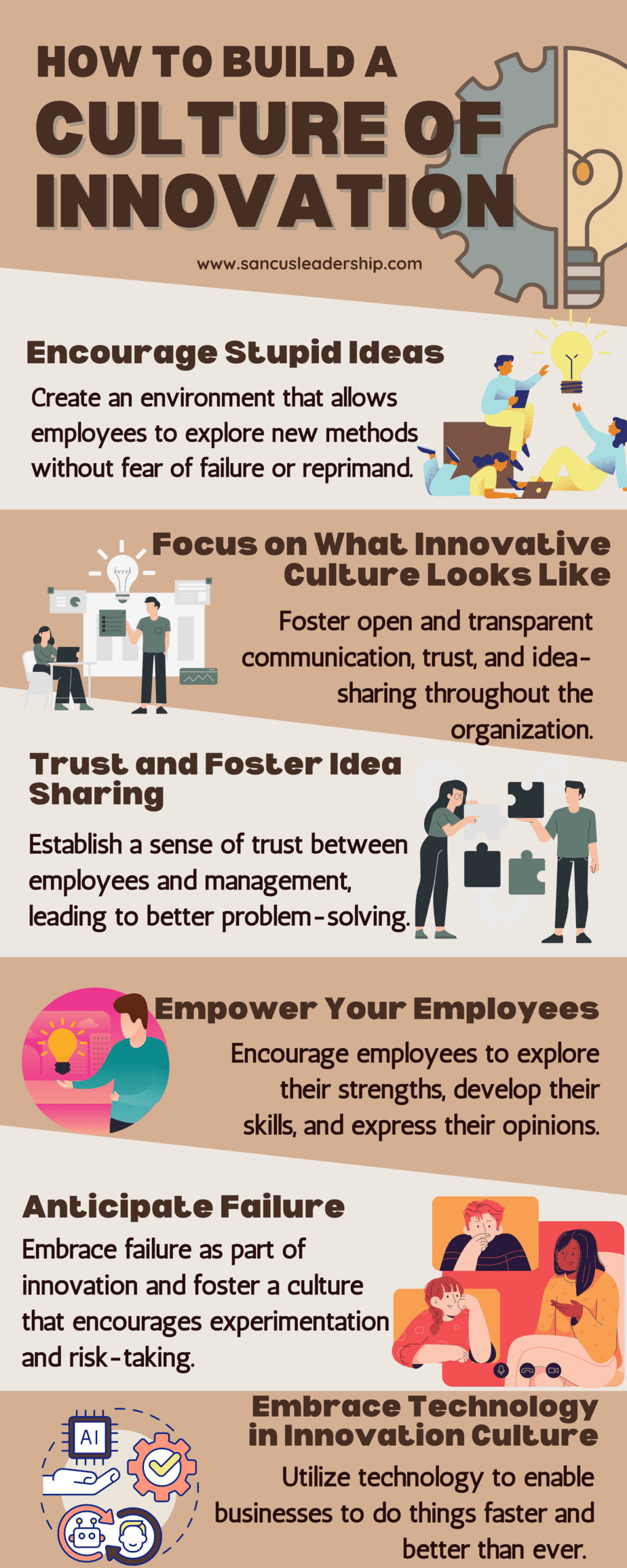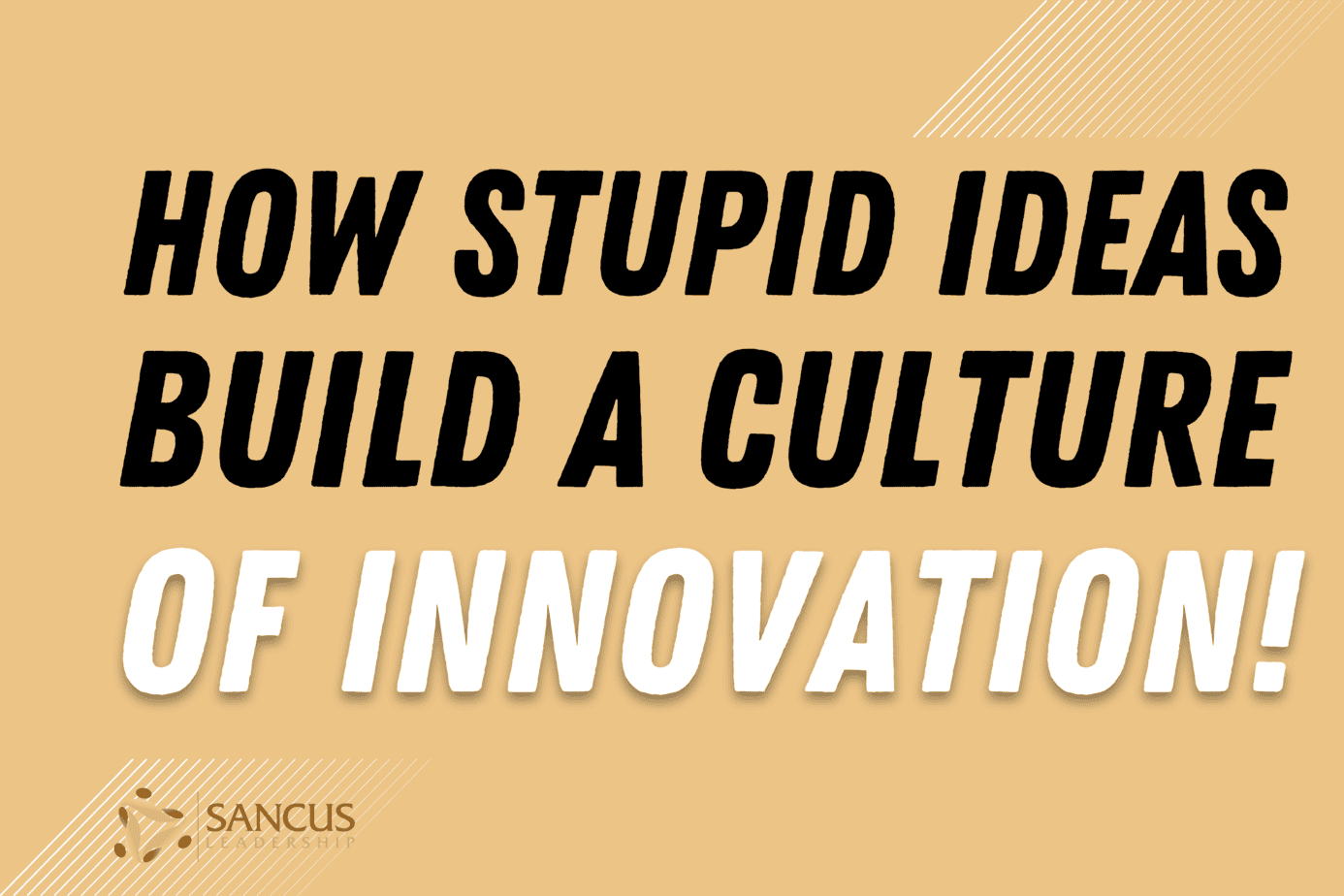If you feel like your business is stuck in the status quo? If so, it might be time to build a culture of innovation in your organization. In my time as an Explosive Ordnance Disposal team leader in the army, the skill that got us out of the most trouble was the ability to see opportunities where others saw problems. But what exactly is this culture, and how can you build it successfully?
Building a culture of innovation means creating flexible teams, setting measurable goals, encouraging collaboration and open communication, and rewarding creative thinking and risk-taking. Creating an environment that allows new ideas to be tested without fear of failure is essential.
If you want to unlock the potential of your team and organization, then creating a culture of innovation is the smart move to make—especially in the modern climate. So, keep reading to discover how to take your business to the next level with the power of creative ideas and out-of-the-box solutions.
1. Encourage Stupid Ideas

A culture of innovation means creating an environment that allows employees to entertain stupid ideas and explore new methods without fear of failure or reprimand.
A culture of innovation means creating an environment that allows employees to entertain stupid ideas and explore new methods without fear of failure or reprimand.
Organizations that stick to the same old ways of doing business will quickly be outrun by the fast-moving changes around them. Since everything around us is moving forward, and if you are trying to stay still, you are actually regressing; this is why it’s so dangerous for businesses to try to stabilize and maintain the status quo.
In some ways, it can be compared to making the same money every year; if your salary doesn’t grow, it will be outrun by inflation, so you’re making less money even though the paycheck is the same.
That means a little bit of innovation or a tiny salary increase (to meet the inflation rate) is what you need to maintain the status quo. But you need to do things differently to outcompete the status quo and be ahead of the changes.
A culture of innovation is important because it allows creativity to flourish and helps organizations stay ahead of the competition. It also provides an environment where new ideas are welcomed, encourages risk-taking, and promotes collaboration.
This culture encourages employees to test ideas off the beaten path and develop innovative solutions to seemingly intractable problems. Moreover, I have seen this many times, fostering a culture of innovation within the organization builds morale, leading to improved job satisfaction and higher retention rates.
With all this in mind, it’s easy to see why creating a culture of innovation is at the core of any growing business. Let’s take a look at how you can do it!
It Starts With Quality Leadership
Leaders are instrumental in establishing a culture of innovation by providing the necessary resources, guidance, and support to encourage creativity. A leader who’s open to new ideas and willing to take risks can help create the all-important atmosphere of creative problem-solving.
A leader who’s open to new ideas and willing to take risks can help create the all-important atmosphere of creative problem-solving.
We, as leaders, also need to set clear goals for our teams and provide feedback on progress.
Doing so helps everyone stay focused on the same priorities and allows them to measure their successes. Leaders should also consider rewarding employees for developing innovative solutions or ideas that help the organization reach its goals (even if they’re not always successful on the first attempt).
Remember that most new ideas are stupid, but you only need one brilliant idea to compensate for a hundred shitty ones! The people who produce the good ones are the same ones who produce the shitty ones.
So If you want to find the great idea, you can’t punish the people who produce the stupid ones.
Remember that most new ideas are stupid, but you only need one brilliant idea to compensate for a hundred shitty ones!
Encourage Collaboration
Collaboration is critical to fostering a culture of innovation. Encourage different departments and teams to collaborate when brainstorming new ideas, and create channels for open communication between everyone in the organization. This helps ensure everyone’s voice is heard and no one’s thoughts are ignored.
It can also help to ensure nobody’s blinkered by the narrow focus that comes from dedication to a single department.
This is where the power of diversity truly comes into place. If you have a diverse team, and I’m not speaking about hair color, skin color, or any other type of visuals.
I am talking about having a different opinion and constructively voicing it to the team; then, you can find and explore new views on old problems.
Innovation requires clear objectives that everyone can work towards together with enthusiasm. Develop a shared vision that sets the tone for how everyone should work together to make it a reality. This shared vision guides and motivates everyone to strive toward success.
Ensure that your employees align themselves with the company’s vision, and find a way to communicate that idea so that it resonates with your people!
Reward Creativity
Rewarding innovation and creative thinking are essential for creating a culture of innovation. Positive reinforcement helps encourage employees to think outside the box and come up with new solutions. It also helps remove some of the trepidation employees may feel when “sticking their neck out” in a new direction.
If every time someone “sticks their neck out” and gets beaten down, you can be pretty sure no one’s ever going to take a risk presenting a new idea again.
Celebrate Success
Once you’ve achieved success, remember to celebrate it! Again, this helps create an atmosphere of accomplishment and reinforces the idea that innovation is valued in your organization.
It also creates a positive cycle of motivation as employees are more likely to continue developing innovative solutions if they know their efforts will be recognized and rewarded.
It is vital that your reward is something that the recipient sees as beneficial to them, not something you assume they would. Take it from me. I’ve learned it the hard way; it made me look like a fool.
It is vital that your reward is something that the recipient sees as beneficial to them, not something you assume they would. Take it from me. I’ve learned it hard way; it made me look like a fool
| How to encourage innovation | Explanation |
| Quality leadership | Leaders must provide resources, guidance, and support to encourage creativity and set clear goals for teams. They should also reward employees for developing innovative solutions. |
| Encourage collaboration | Different teams should collaborate when brainstorming new ideas, and channels for open communication should exist throughout the organization to ensure everyone’s voice is heard. |
| Create a shared vision | A shared vision helps guide and motivate everyone to strive toward success, and employees should align themselves with the company’s vision. |
| Reward creativity | Positive reinforcement encourages employees to think outside the box and come up with new solutions. |
| Celebrate success | Recognize and reward innovation, creating a positive cycle of motivation. Ensure rewards are meaningful to the recipient. |
2. Focus on What Innovative Culture Looks Like

An innovative culture looks like an environment where everyone can explore new ideas, take risks and think differently. It’s a place where collaboration is encouraged, and failure is seen as an opportunity for growth.
An innovative culture looks like an environment where everyone can explore new ideas, take risks and think differently. It’s a place where collaboration is encouraged, and failure is seen as an opportunity for growth.
But how does this play out in a practical setting? And how can you make this your new business reality? Well, here are a few things to keep in mind.
Open and Transparent Communication
Encouraging open and transparent communication starts at the top, with management setting an example for their teams. Leaders should provide clear direction and expectations but also be willing to listen to different ideas from the group.
I have seen this in action. It creates an atmosphere of collaboration where employees feel comfortable offering their thoughts (even when they may not perfectly align with the company’s vision). It also establishes a sense of trust between employees and management, leading to better problem-solving in the long run.
Trust and Foster Idea Sharing
Building a trusting environment within the organization fosters creativity and innovation. When employees feel safe expressing themselves without fear of reprisal or failure, they’re more likely to submit ideas without reservation, leading to breakthroughs that benefit everyone involved.
Remember! To reach that one good idea, you’ll probably have to suffer through many bad ones.
Remember! To reach that one good idea, you’re probably gonna have to suffer through a lot of bad ones.
Intentional efforts should be made by leadership to make sure team members have an opportunity to collaborate on new projects or provide input on initiatives they feel passionate about.
Habitualize a Feedback Culture
Creating a culture of continuous feedback allows for more efficient problem-solving and helps build morale among team members and management.
Regularly scheduled meetings or forums allow open dialogue between management and team members for everyone’s perspective to be heard instead of just what’s been decided by higher-ups behind closed doors.
While this type of feedback can take time, it ultimately leads to better outcomes, allowing multiple levels within the organization to weigh in on decisions before finalizing them. This leads to fewer missteps down the line due to a lack of input from all involved parties.
Most of us feel that feedback is anxiety-generating to some extent. But the cool thing is, if you do anything for a long enough time, the anxiety will disappear and become mundane.
3. Empower Your Employees

It’s no secret how businesses that empower their employees perform better. Giving your staff autonomy and ownership of tasks allows them to feel valued and engaged at work and encourages innovation.
But how can you do this effectively?
In truth, it’s simple: Create an environment where employees can:
- Explore their strengths
- Develop their skills
- Express their opinions
Not only will this help build trust between employers and employees, but it also helps foster an innovative culture throughout the entire organization.
Give Employees Autonomy and Ownership
When employees know they’re trusted and can make decisions independently, they become more invested in their work. This allows them to think creatively and develop more meaningful solutions to problems.
It also encourages risk-taking, which is essential for fostering a culture of innovation.
Provide Opportunities for Skill Development
Provide your employees with opportunities to learn new skills or hone existing ones. This will help them stay engaged in the workplace and make developing inventive ideas easier.
It’s also wise to provide ways for employees to collaborate as a team through team-building activities or engaging exercises that encourage brainstorming fresh ideas.
Most people start questioning their job when they become stagnant in their development; this means that if you can keep your people engaged in self-development, it is more likely that they will stay around for long for many years.
I use this exact technique to keep my team together longer than anyone ever had done before at my company.
Encourage Experimentation
Innovation requires experimentation, and sometimes things will go differently than planned, but learning from failure is part of the process. Give your employees space to take risks without fear of repercussions if something doesn’t work out.
For example, this could mean giving them access to experimental projects or providing incentives for ingenious solutions. Yet by enabling employees to experiment freely, you open up the possibilities for breakthroughs that could benefit your company and even the broader industry.
This reminded me of when Google had 1/5 of its working hours dedicated to innovation (Maybe they still do). Engineers could work on whatever project they enjoyed as long as it had some connection to the business’s overall goals; this is actually how Gmail came to life.
4. Anticipate Failure

Innovation is never a smooth, linear process—so failure is natural and expected. It’s important to embrace failure as part of innovation and foster a culture encouraging experimentation and risk-taking.
Leaders need to create an atmosphere where employees understand the acceptable risks’ limitations, which is also called risk tolerance. Train your people on risk assessment and allow them to move freely within the tolerated risks.
When the pressure to produce only good ideas is removed, employees can think more freely and develop creative solutions that wouldn’t have occurred otherwise.
A Natural Part of the Innovation Process
Failure at every stage of the innovation process should be regarded as an opportunity for learning. After all, it’s essential for growth!
Failure at every stage of the innovation process should be regarded as an opportunity for learning.
Moreover, failing doesn’t mean starting from scratch.
Instead, it means recognizing what went wrong and taking steps to fix it or learning from your mistakes. This also helps create an atmosphere of experimentation within your business, encouraging fresh ideas.
I like to take a scientist’s perspective; a scientist never fails. They merely go into the world looking to test a hypothesis, but whether or not it is true matters less than the lesson that can be learned from the test.
So go out there and test your hypothesis!
Learn From Failure and Move Forward
It’s essential to recognize that failure is not the end but an integral part of the innovation process. Celebrate successes, but don’t shy away from admitting mistakes either.
In the book The Way of the Seal: Think Like an Elite Warrior to Lead and Succeed, Mark Devine (ret. Navy SEAL) speaks about failing forward fast, it’s a concept where you anticipate failing, but you also anticipate learning from it, this allows you to put up strategies and processes so you can learn as fast as possible and continue moving forward.
If something didn’t work out, talk about it honestly:
- What went wrong?
- What could you have done differently?
- What new strategies could you employ going forward?
Your company can continue to innovate and improve by learning from each failure.
5. Measure and Track Progress

Measuring and tracking progress is essential to ensure that your innovations are successful. By setting measurable goals, tracking progress, and continuously refining and improving your methods, you can guarantee that whatever product or process you create will be successful in the long run.
Set Measurable Goals
When creating a new product or process, setting measurable goals to track progress is important. Define the parameters of success in advance. Understanding the outcome you want to achieve makes it easier to plan out how to do it.
Track Progress and Success
It’s vital to track progress and success to measure your effectiveness. Set up systems that record data such as customer feedback, sales figures, user engagement levels, and more.
You can use this data to gauge the success of your products or processes. This data will also help inform your decision-making regarding changes or improvements that need to be made.
Continuously Refine and Improve
The innovation landscape is constantly changing. New technologies emerge daily that enable businesses to do things faster and better than ever. Companies need to remain flexible and open to change to stay competitive.
Constantly track performance metrics and monitor market trends to identify improvement or adjustment opportunities.
6. Embrace Technology in Innovation Culture

In the modern world, technology plays an essential role in innovation, which you must recognize if you want to stay ahead of the competition. Let’s examine how this plays into the innovation culture you’re trying to create in the workplace.
Technology Is Changing the Way We Innovate
Technology has drastically changed the way businesses operate. Innovative new tools are being developed daily to streamline operations and open up new possibilities for product development.
For example, software such as machine learning algorithms can analyze vast amounts of data quickly and accurately. At the same time, cloud computing makes storing and accessing large files quickly from anywhere.
The recent launch of ChatGPT will most likely revolutionize the way we process big data for small teams.
The Impact of Digitalization
Digitalization has had a considerable impact on organizational culture as well. Technology has helped make companies more agile and adaptive—businesses can now respond to changes in market conditions faster than ever before.
Additionally, digital tools have enabled easier collaboration between different departments or teams across global borders, making teamwork more efficient and increasing employee engagement.
A place where I go to find a lot of great insights is Gallup.com. They do some extensive analysis and data gathering that is incredibly useful for us small business leaders.

Best Practices for Integrating Technology
To ensure you’re getting the most out of your technological investments, it’s important to establish best practices for integrating technology into an innovative culture.
Here are a few tips:
- Establish clear goals for each project before investing in any new technologies.
- Develop processes for testing out new technologies with small pilot projects.
- Invest in training for employees who need help adapting to newer technologies.
- Encourage collaboration between different departments so everyone’s on the same page.
Here is a video of a technologist, educator, and innovator, Don Buckley giving a talk on how to build a culture of innovation and its importance.
| Steps to Build a Culture of Innovation | Key Points |
| Encourage Stupid Ideas | Create an environment that allows employees to explore new methods without fear of failure or reprimand. |
| Focus on What Innovative Culture Looks Like | Foster open and transparent communication, trust, and idea-sharing throughout the organization. |
| Trust and Foster Idea Sharing | Establish a sense of trust between employees and management, leading to better problem-solving. |
| Empower Your Employees | Encourage employees to explore their strengths, develop their skills, and express their opinions. |
| Anticipate Failure | Embrace failure as part of innovation and foster a culture that encourages experimentation and risk-taking. |
| Embrace Technology in Innovation Culture | Utilize technology to enable businesses to do things faster and better than ever. Remain flexible and open to change to stay competitive. |
Final Thoughts
Innovation is a key driver of success for any business in the modern world. Technology can give you a leg-up to stay ahead of the competition, but it’s important to remember that innovation is more than just technology.
It’s also about having a culture and mindset that embraces change, encourages collaboration, and sets up processes for continuous improvement.
Ultimately, the organization’s management and leadership will determine the innovation’s effectiveness. But by investing in the right people and processes, leaders can create a culture of innovation that propels them toward genuine success—both now and in the future you’re driving toward.



